|
FAQs on the Hydrozoan Identification
8
Related Articles: Hydrozoans, Cnidarians, Fire Corals, Stylasterines, Hydrozoan Jellies,
Related FAQs: Hydrozoan ID 1, Hydrozoan ID 2, Hydrozoan ID 3, Hydrozoan ID 4, Hydrozoan ID 5, Hydrozoan ID 6, Hydrozoan ID 7, & Hydrozoans 1, Hydrozoans 2, Hydrozoan Behavior, Hydrozoan Compatibility, Hydrozoan Selection, Hydrozoan Systems, Hydrozoan Feeding, Hydrozoan Disease, Hydrozoan Reproduction,
Medusoids/Jellies (Ctenophores, some Hydrozoans,
Scyphozoans): Jelly Identification, Jelly Behavior, Jelly Compatibility, Jelly Selection, Jelly Systems, Jelly Feeding, Jelly Disease, Jelly Reproduction, Fire Corals, Lace Corals,
Stinging-celled Animals
|
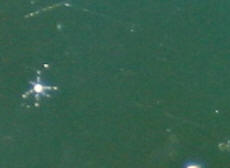
|
|
Red algae ID 2/11/18
Hello, I wrote in many months back and you were super helpful identifying some
algae for me. I hope you can help again! I have attached a photo of the reddish
pink tree-like algae that is spreading like wildfire through my tank. I didn’t
see anything like it in your algae ID archives... can you tell me what it is?
<I wish I could... the regular branching... I don't think this is an algae/Thallophyte,
but a very pink Hydrozoan of some sort>
Does anything eat it that I could use to help control the spread? Thank you!
-Sarah
<There are some notable Seaslugs that ingest various Hydropolyps, but I don't
know anything re this particular one. I would remove it from the system, as it
may be producing stinging elements that will bother your other livestock. Do you
have a microscope with a USB connection? I'd like to see some 100-200, 400 time
magnification shots. Bob Fenner>
|

 |
|
Re: Red algae ID 2/12/18
Hi Bob, I don’t have a microscope unfortunately.
<Perhaps a local fish store does, someone from a marine aquarium club>
I have tried some manual removal but ripping it off leaves traces behind
that I cannot remove, and it is widespread, including my tank overflow box
and powerhead. It also grows very very fast.
<Yeeikes! I wish I could tell definitive what this is. I have never
encountered something this shade of pink, nor with the array of branching it
shows>
Is bleaching my tank and starting over my only option to eradicate this
pest?
<It may well be>
Also, can it sting fish or just corals?
<Can't tell w/o testing or microscopic looking. BobF>
Thanks again.
Sarah
|
|
re: Can't ID hair like growth in reef aquarium(SMALLER SIZED PICS)
9/6/17
Mr. Fenner
<Matthew!>
Here I bought a stereo microscope and took pictures of the pictures of the hair
like growth being told. Hydroid digitate, Bryozoan Bryopsis, algae of
unknown... Can someone please help me now??
<Mmm; well the color, strands remind me of algae... are there cell walls in the
strings? That is individual cells making parts of the strands? If not, perhaps a
blue green "algae". The expanded tips remind me of the ciliate Vorticella... how
big are these? Could be a digitate hydroid, but so green?
Sorry, can't make out more here. Bob Fenner>
Matthew
|
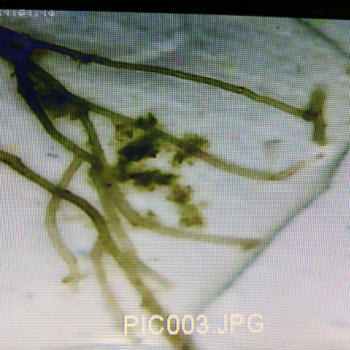
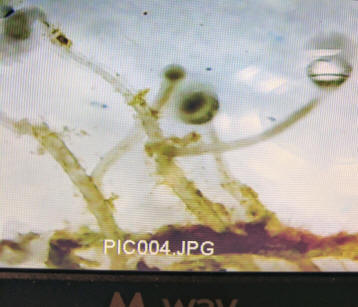 |
|
re: Can't ID hair like growth in reef aquarium (SMALLER SIZED PICS)
9/6/17
Some are 1/4" some maybe 1" but they come back quick...
<Umm; these are digitate hydroids... I'd be removing them>
Let me mess with the new Gadget it says up to 600x. I just held it with my hand
and focused as best as I could I'm going to suction it down to a piece of glass
I did add some distilled water to it I pulled it with tweezers from the base I
was hoping you could identify it by the circle tips at the ends of the object it
looks like a red blood cell but green this is what they look like at there
latest like largest... 1" tall Max. Look white not matter if I use a blue
flashlight or if I use a white flashlight they look the same until I pull them
out of the water then they are green right away I don't know if it's the
oxygenation or if they're just green and look white but they have no feeding
response when I feed my Montipora wouldn't a did you take hydrated have a
feeding response to Reef Roids or Coral Frenzy or even Cyclops I see no change
in anything actually the ones that have peaked in size have ingrown no more but
if I were to pull them off or toothbrush them they would come back not as fast
like tall wise but they come back on the Fred I brush them off when they were
very small and within two days they're still back to their very small stage of
maybe one 20th of an inch did you take my droid have a feeding response to reef
Roids or coral frenzy or even Cyclops I see no change in anything actually the
ones that have peed in size haven't grown no more but if I were to pull them off
or toothbrush them they would come back not as fast like tall wise but they come
back on the Fred's <?> I brush them off when they're very small and within 2
days there they're still back to their very small stage of maybe 1/20 of an
inch. ..
<Pull the affected rocks out... dry>
if I can't figure this out I'm going to trash the library and then quarantine
all my coral into a small 22 gallon frag tank because I'm worried that if I
toothbrush this stuff off put them into a new tank it will just start the
process all over again even though I'm using dry live rock next time or maybe I
will just frag pieces of SPS that don't have any
near it but it's the track of philia that I don't know if it has these things on
the small base underneath they don't grow on any fleshy Parts only on hard
surfaces except glass... I noticed them growing on my overflow wall there is
none in my refugium skimmer compartment because which is weird I have a 300 watt
Mars light and a macro reactor and a CFL light growing some red color for red
kelp tree like red grapes growing on a vine None but in the display...
<Thank goodness>
If I can't figure this out I'm going to most likely have to throw away a lot of
corals that I've been nursing back from that product vibrant liquid aquarium
cleaner and caused my anemones to basically shrivel up and it did nothing to
this stuff after five doses I will try to get a better photo more detailed of
the cell walls I mean the box of this microscope stereo microscope shows this
thing looking at organisms not just maybe that's the picture I took of this
stuff was maybe 40-50 X I mean looking at a hair is not that impressive when it
advertises 600x maybe it's the distance I had it at it was too close Maybe I
know it wasn't too far away... Just another question I bought some live rock
drive from BRS.
<... see others opinions.>
The curing process. Just sit in barrel for few months small WC every week maybe
and when no nitrite there ready? But how long do u leave em in there so there
actually live and not just the decay wearing off and no po4 leaching.,. Also
when I start so I have to seed with i.e. Biospira or an alrdy cured LR (NOT ONE
OF MINE) even though some have these things on them while some but taking the
risk isn't my biggest thing. I notice they don't sting cut irritate the sps and
stunting growth. I have my macroalgae reactor running now and I also reinstall
my algae Turf scrubber which the vibrant aquarium cleaner people told me to take
off line so I'm hoping after that I've already
noticed a tripling of my Chaeto that I put in there a very small amount that you
twist tie onto the plates and I'm also going to reinstall a new UV light I
haven't had a UV running for about 8 months now but I think a recent tail rot
and a Popeye incident in two separate fish I think UV would not be a bad thing
<Is a good thing>
and maybe when I toothbrush these things off it might stop the spreading of
these or regrowth because the spores if any will die once they go inside the UV
chamber fingers crossed thanks for your response and if you could please reply
about the live rock curing that would be great thanks again you guys are
wonderful for taking the time to answer regular folks like me that sometimes the
answers might not even be there ever.
With much appreciation
Matt Macri
<Welcome to my input. Bob Fenner>
|
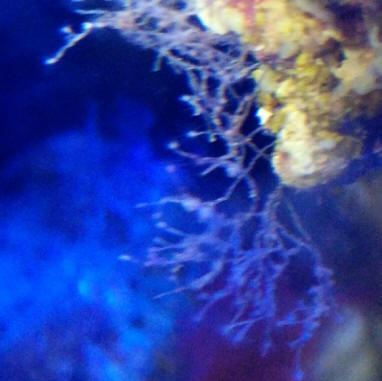 |
|
re: Can't ID hair like growth in reef aquarium (SMALLER SIZED PICS)
9/6/17
What about taking one rock out... Putting in a bucket of tank water with heater
and pump... Cover it dark for three days and see if it dies..
<Mmm; not likely to die this way; but go ahead and try it>
How long can you dark out a tank safely without killing Coral?
<Depends, but likely the corals will die at about the same rate/exposure>
Ppl do it for Bryopsis etc.. I can hammer a piece of rock that the top half has
the largest strands of this stuff.. it's a large branch rock with s large green
Monti growing from a small ledge in the middle of it.. I was thinking of
basically halving it and black it out for 3-4 days and if it kills it.
It's an algae and I should do it to my whole tank....
Your input?
<Physically systematically removing, scrubbing off (and rinsing) outside the
tank is my fave, direct approach... There are folks who advocate chemical means
of burning, sealing... There are some potential predators including Nudibranchs,
Seaslugs, Urchins, possibly fishes (e.g. dwarf angels) that might consume this
pest>
I've never had a pest issue in 2 years I always found natural remedies like
Emerald crabs or Turbo snails are sea cucumbers to keep mice and overturned or
Nassarius snails to do the same thing bristle worms to eat overfed food always
having a quarantine tank at Bay in case something happens always not being cheap
on equipment even though I'm on disability but I save my money rather than
buying cheap stuff I buy the good equipment this way it doesn't break or
electrocute me or there's all kinds of stuff that can happen but I also buy a
backup that's less expensive just in case... I just don't want to have to
somehow take my fish somewhere else to a fish store which I can't monitor mean
for all I know they could be breaking out and diseases and dying cleaning my
tank out putting my Coral in a small frag tank with an acrylic box filter and
basically scrubbing my tank with water and bleach and then scrubbing out my sump
as well..
Done cycling my tank curing my live rock which isn't going to be new dry live
rock once it's cured I have to re cure it so there's no phosphates linking or
put it in my tank fish only for a month or two while the phosphates Leach out
and then put my corals back in my tank once the phosphate start reading zero
again that's a very very long and tedious process and I would have to find a
place for all my snails crabs cucumbers pet shrimp of many sorts but I have a
quarantine tank that is medicine free I could just add a few of the bad live
rock in there to give them places
to hide and just Neil
<?>
throw some food in there once in awhile some algae Wafers some other kinds of
food just to keep him alive and sand on the bottom for my Tigertail cucumbers
one is almost 2 ft long and the other is about 10 inches and I definitely don't
want them to die them are one of my favorite things to look at when they come
out
Matthew
<Bob Fenner>
re: Can't ID hair like growth in reef aquarium (SMALLER SIZED PICS)
9/6/17
What if I remove the affected rocks couldn't I significantly lessen my biofilter
<? I wouldn't remove the rock permanently... Just to scrub/clean it. B>
|
|
Hydroid ID and control 5/4/16
Hello WWM Crew,
<Josh>
I have noticed a great deal of what looks like some kind of stringy white
algae growing in the darker, lower flow section of my large reef tank (under
shelves and overhanging rocks, etc.).
<Mmm; no; these are Hydropolyps; not algae>
I didn’t think much of it, but I noticed recently that previously happy
Zoanthid colonies are now staying closed most of the day, and longer
spreading or fluorescing nearly as much as they should. It appears the two
observations may be related, as I can see a few of these same stringy,
branching, algae-looking structures extending up through the affected
Zoanthid colonies. On closer inspection, I can see that the stringy hairy
things have what looks like a feather duster fan or even a tentacled polyp.
I’m starting to believe that they’re a type of hydroid, and am wondering if
there’s anything I can do to stop them overtaking and killing my beloved
Zoas.
<Sure: Read here: http://www.wetwebmedia.com/hyzoancompfaq.htm
Below is a photo of some of the culprits — I believe the span of the
tentacles is less than 2mm, on average. I’d be grateful for any help in
ID’ing the species,
<Mmm; see WWM re Hydrozoan ID>
as well as any suggestions you might have on how to reduce their
proliferation.
Thanks,
Josh
<Welcome. Bob Fenner>
|
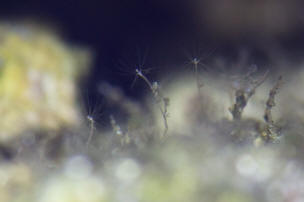 |
|
Something Odd on my Green Star Polyps
11/23/15
Hello WWM:
<Hey Will>
Thank you for what you do for the hobby.
<Welcome>
I have had a green star polyps frag for about 6 weeks. I am new to the hobby,
running a 92 gallon corner tank that was a hand me down. I have a 25 gallon
sump, UV sterilizer, media reactor running NPX BioBalls, and a sea Urchin
skimmer.
My GSP is attached to two small LR branches, along on a LR shelf. The LR is the
kind that LFS sells that was made in California and is synthetically impregnated
with the LR bacteria - not a lot of likelihood of hitchhikers.
<Mmm>
About 10 days ago I noticed one or two small flowery looking things that come
out when the lights go out and the GSP recedes. People online have theorized
that it is aphasia. Or algae.
<No; looks like Hydrozoans.... perhaps Myrionema genus by name. At any length
you can use this to look up re on WWM, elsewhere>
I have taken it out in an effort to tweeze it away, but only got a small piece.
I also see many new little white conical sponges on the frag mat. There or some
of these on the other side of my tank as well. I have attached one high light
and one low light picture of the GSP.
Are the sponges bad? Are they bad in the tank? Do you have an opinion about the
"stalk" coming out of the frag?
<Sponges not likely bad>
I cleaned my sump last Wednesday, when I did see one Aiptasia (no doubt about
it) and I removed the carbon filter bag that it was attached to. I am thinking
of getting rid of the whole frag, unless you think this is a benign thing on the
GSP.
<Not benign; unfortunately. Read on!>
Thanks and Happy Thanksgiving!
William
<And you, Bob Fenner>
|
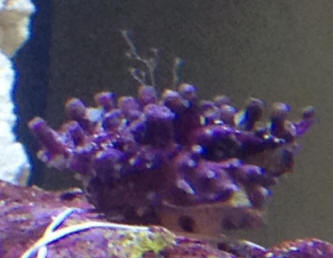
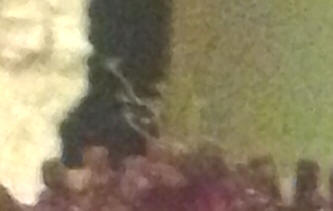 |
|
Re: Something Odd on my Green Star Polyps
11/23/15
I will remove the frag at once. Is there any chance that it has not spread
throughout the tank? Or am I doomed?
<There is a chance; and you're not doomed. Sheesh. BobF>
|
|
Look what I found
8/26/14
Found this on the beach this morning. Though at first it was plastic but
when I picked it up it felt
real. Any ideas
<Ah yes; a remnant of a colonial Hydrozoan: Velella. BobF>
|
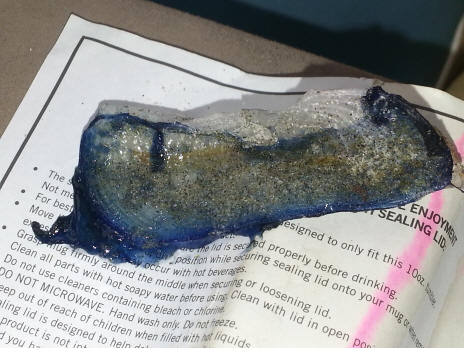 |
|
Help with Identification Please
8/1/14
Hello,
<Dustin>
I’ve really been struggling with getting a legitimate identification of this
particular “thing” in my aquarium. I’ve provided three photos, one you’ll be
able to see is growing from a rock, the other is scaling the back wall of my
tank.
I’ve heard everything from hydroids, Foraminiferans to bryozoans. Any thoughts?
Good or bad?
<These are almost certain stinging Hydroids... undesirable. You can read re
their control/removal on WWM. I would siphon while snipping...>
Thank you in advance,
Dustin Betterly
<Welcome. Bob Fenner>
|

 |
|
Re: Help with Identification Please
8/1/14
Do they spread?
<Some species more than others... very common group of organisms on the world's
reefs>
I pulled them with my fingers and felt nothing, but
maybe I wouldn't, not sure.
<Some more stinging, stickier than others... folks fingers, hands are
callused... Don't touch around your eye...>
I've checked out the WWM and I find it a bit confusing. I'd prefer to
not nuke the tank if possible.
<I wouldn't over-react; do this>
Some people have said that since the
tank is so young they might disappear on their own. Just looking for
some answers.
<... Ask better questions. B>
|
|
Odd flower like object on live rock, green and very tiny
2/1/14
I found the attached object on my live rock recently and cant figure out
what it is, even after hours of Google searching, including your site!
<Mmm, looks Polypoid... My guess is on some sort of Hydrozoan... Does it
"sting", stick to a sensitive part of your wrist? Yowch!>
The live rock I bought only stated that it is usually from the South
Pacific but could be from anywhere.
The object is ridiculously small, maybe 1/4" high and a few mm wide. It
doesn't come off the rock with a baster like algae (I do have diatoms
and GHA). I originally thought it was a new strand of algae.
I have asked over at Nano-reef forums but the only idea I got was that
it could be some sort of macroalgae. This tank has only been up for
about 6 weeks and currently only has live rock in it.
I have only noticed this one in the tank and it's stationary, I haven't
noticed if it looks any differently at night than during the day. My
apologies that the pictures aren't better.
Thanks,
Cathy
<Welcome! Thanks for sharing. Bob Fenner>
|
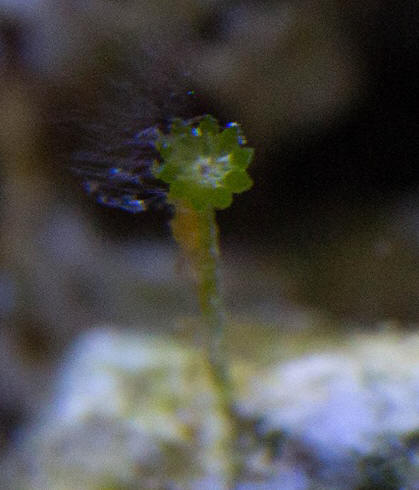 |
Re: Odd flower like object on live rock, green
and very tiny 2/1/14
Thanks Bob, I've never touched it so not sure if it stings! I'll see if I
can trick my boyfriend into finding out...
<Heeee! Good idea... the wrist, not callused hands or fingers. BobF> |
|
Coral identification 4/14/13
Crew,
<Paul>
My LFS had some corals on sale so I decided to pick some up but they
didn't have names or labels attached to them. Could you please help me
with the identification?
<Mmm, can guess... the first and last (the two w/ stony skeletons) are
Mussids of some sort... maybe Lobophyllia/s... the other (sans hard
parts) appears to be some sort of Zoanthid... see WWM re these... can be
problematical for other Cnidarians and humans>
Also what is that arm coming out of the green one?
<Can't quite make this out. If it's still there, send along a bit
larger, well-resolved image... otherwise, it looks to be some sort of
trailing mucus>
It would make my life easier if they were better at labeling the stock :(
I also picked up a chunk of live rock and much to my surprise it came
with a small Lawnmower Blenny!!! I was doing some reading on this fish
and it sounds like they can nip at corals.
<Mmm, not usually though. Are very "in" to types of algae>
Beside the 3 in the pictures I have a Kenya Tree coral, 1 Green Hairy
Mushroom and a small Frog Spawn frag. Are these at risk from the blenny?
<Not likely; no>
One more concern I have is what to stock in this tank. I have been
reading over the site (haven't gotten through it all yet) trying to
figure out what the most hardy, colorful fish that i could put in there.
Most common angel and butterfly fish seem to be out. Could you offer any
suggestions of some families of fish I could research or is this on wet
web and I just haven't found it yet?
<Mmm, likely a good idea to urge you to read here:
http://www.wetwebmedia.com/RfLvstkgF15.htm
and the linked files above... you'll find plenty in your own searching
here>
There is so much information out on your site and the web that is gets
confusing when everyone has an opinion on what will work and what wont.
<You can trust what we offer>
Thanks so much for your help!
Paul
<Welcome. Bob Fenner>
|
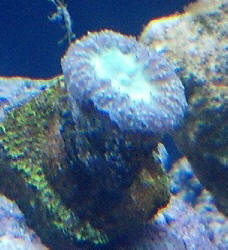
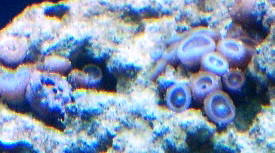
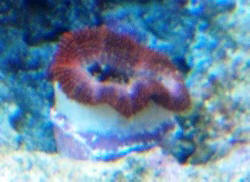 |
Re: Coral identification
4/14/13
Here are some more pictures. Best my phone can do since my wife took the
fancy camera with her on vacation.
<Ahh, and am wondering... these now appear (more than one... see the ones
lower, on the left side?) to be hydrozoans... I would carefully brush these
off (outside the tank) w/ an olde/soft toothbrush... You don't want these to
proliferate in your system. BobF> |
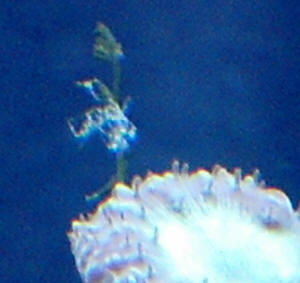
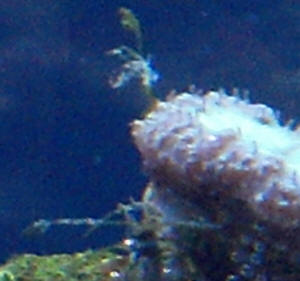
Re: Coral identification 4/15/13
Yes I was talking about the Hydropolyps. Sorry should of been more clear.
I was reading over the Hydrozoan FAQ but I didn't see any pictures that
match what I but at least I have a better understanding of what I am going
against in case I didn't pull the frag out in time. Your team as amassed
such a wealth of knowledge on this site I wish I had time to read it all!!!
<Ahh!>
I read through the thread that you sent me in your first reply and I think I
have a suitable list of livestock just need to do more research as to who
gets along with who!!
<An adventure for sure!>
Thanks so much for your help!
Paul
<Ah, welcome. BobF>
|
|
Identification help 2/5/12
Hi Team
<Carlos>
I recently noticed these critters on the walls of my refugium. I
haven't noticed them in the display tank. The tank is now 5
years old, a mixed reef, and doing well. I have enclosed a couple
photos:
<Nice... Jellies galore!>
There are several small hydroid type creatures attached to the
wall and can be seen in photo 1.
<Yes... are Medusoid stages of Hydrozoans...>
Along with them I noticed this tiny umbrella shaped creature
which is free-swimming. It quickly pulsates and almost looks like
a tiny jelly-fish. It can be seen in both pictures. Any
thoughts?
Thanks a bunch
Carlos D.
<Mmm, I'd be doing what you can to limit their
reproduction, presence.
Please read here: http://www.wetwebmedia.com/jellycompfaqs.htm
Bob Fenner>
|
|
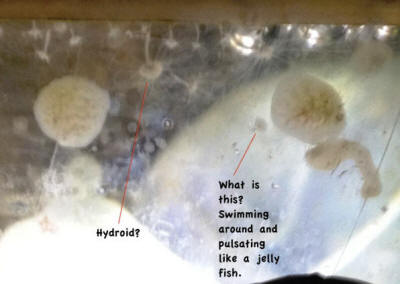
|
Re: Identification help
2/5/12
Thanks Bob! Appreciate the help. Presently only in the refugium so
I will keep an eye on things and if need be I guess i can take the
refugium off-line and clean it out and start over.
<I see>
thanks again
Carlos
<Welcome Dr. C. BobF> |
|
Identification 10/25/11
Hope you can help ID this! It has long white tentacles that have
a fan looking attached. The tentacles look spider web thin and
retract when the lights come on. They grow out of a sac looking
thing that looks like it can attach to anything. The first
picture is of the sac and the second is of the tentacle.
<Appears to be a hydroid/Hydropolyp of some sort. See WWM re.
Bob Fenner>
|
|
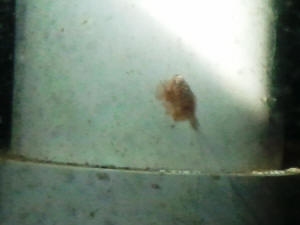 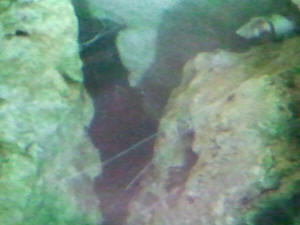
|
re: Identification 10/25/11
Are they good bad harmful.
<? What is it w/ people? READ: http://wetwebmedia.com/hyzoancompfaq.htm
DON'T write. B>
It almost looks to have a jelly sack and a long string like thing
coming out tank is full of them at night when lights are out, when
your yurn lights on you can watch them retract there arms. |
|
Filter/Suspension Feeder I.D. 10/4/11
Good Morning,
<Threeish in the PM here in Fiji presently. Bula!>
I have a curious animal that has recently taken up residence
(become prolific) in my little reef.
I have attached an image:
<Mmm, nothing attached>
Demonstrating it's unique (to me) means of increasing its
colony(?).
Regarding its behavior: As far as I have observed over the weeks
since discovery, the animal(s) are benign, and appear to be very
simple suspension feeder (worm?) that spreads via filamentous
thread that produces a fan type filter evenly along it's
length. They (it) is easily removed with light scraping of the
glass. It is most evident on the glass wall, however, it is
present on most surfaces via the filter. It appears to double
it's size every few days.
As for the environment that I provide: I have made great effort
to mimic natural reef/lagoon I saturate the water column with
fine particulate food in hopes to foster growth primarily in my
stony coral colonies, secondly in my burgeoning sponge
population. I assume that has benefited all suspension feeders
.
I hope you could help me with identifying this bizarre (to me)
animal, and at the least point me to a resource.
Best Regards
--
Ronald E. Tibbetts
<Please do send along a well-resolved image. Bob Fenner>
Re: Filter/Suspension Feeder I.D. 10/5/11
Even after all these years you can't just drag and drop an
image into an email.
<Ah yes (no). I take it you're seeking the ID not of the
cucumber above right, but the net-like mass attached to the
wall... This looks to be some sort of Hydrozoan... I would be
wiping this off and vacuuming out as much as I could. Too likely
stinging to be comfortable. Please read here:
http://wetwebmedia.com/hyzoancompfaq.htm
and the linked files above if you'd like more related input.
Bob Fenner>
|
|
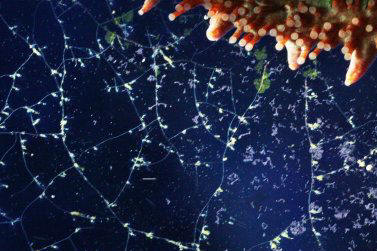
|
|
Feather-like Filaments on Trachyphyllia
10/2/11
Hi WWM Crew! I have an Australian Trachyphyllia at the LFS I
currently work at which has some type of feather filaments
attached to the outer part of its tissue, toward the
skeleton.
<I see these... Hydrozoans/Hydropolyps>
I have never seen this before and would like some assistance in
identifying it. I believe it is some sort of worm or other
hitchhiker that extends feather-like tentacles for capturing
microfauna (similar to Feather Dusters and Porcelain Crabs).
<Similar, but more deadly... not just physical, but stinging,
agglutinant>
The long feathers stretch out then will quickly retract to its
point of origin and will then slowly extend again. I have
attached some pictures and a link to a short video to help
explain in better detail.
http://s351.photobucket.com/albums/q449/MarineScene/trachy%20video/?action=view¤t=MVI_9342.mp4,
sorry for having to turn your head to properly view the video, I
forgot that I can not rotate video from my PowerShot camera. Any
help is appreciated and thank you for a great and informative
website that I use quite frequently!
Thank you,
Melissa
<Let's have you start reading here:
http://wetwebmedia.com/hyzoancompfaq.htm
Perhaps the linked files above. Then write me/us back if you have
further concerns, questions. Bob Fenner>
|
|
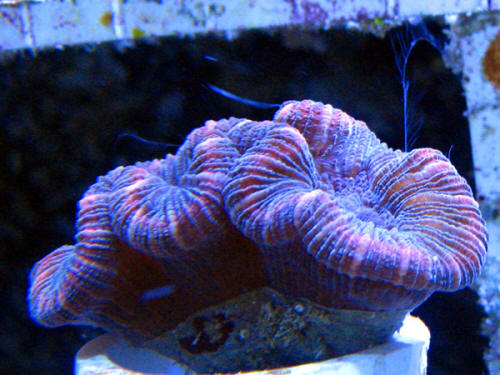
|
|
Micro-invert ID 6/28/2011
Good afternoon, crew,
<Dan>
I have just recently seen several of these little dudes in my
'fuge. I have searched to the darkest end of the web (may
have missed a spot or two), and am clueless. Although I have NO
idea what they are, they are fascinating little creatures. The
"tail" appendage telescopes from about 5mm to 50mm and
retracts again, leading me to believe it is a feeder arm of some
sort. The main body is about 2-3 MM in length.
Can you give me a vector, Victor?
<I do think you have a Hydrozoan/Hydropolyp species here...
I'd vacuum these out. Stinging if they get into your main
system and eating you refugium production where presently
encamped. Bob Fenner>
Dan
|
|
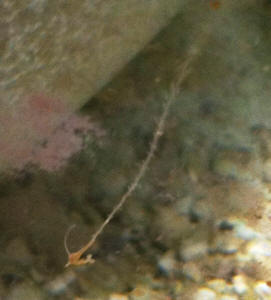
|
Re: Micro-invert ID
6/28/2011
Thank you. Since my email, I've counted at least 10 so far in
my fuge.
Going to be fun getting them all out of my Chaetomorpha!
<Might I suggest a bit of rigid airline tubing attached to the
airline as a siphon? BobF>
Re: Micro-invert ID 6/28/2011
Exactly the set-up I used to siphon off the red-brown Planaria that
went nuts in my tank earlier. Works very well. I'm a bit more
concerned about actually finding all the little freaks hidden in
the Chaeto. Maybe remove and rinse it all?
<Worth trying. B> |
|
What is this, and how do I get rid of it?
This came as a hitchhiker on a frag from a LFS and it has now
spread to plague like proportions. What is it, and more
importantly, how do I get rid of it?
<Mmm, Hydropolyps, Hydrozoans... read here: http://wetwebmedia.com/jellycompfaqs.htm
Thanks for the info. I love this website. You guys are doing such
a great service donating your time and knowledge. Thanks.
Nick
<Welcome. Bob Fenner>
|
|
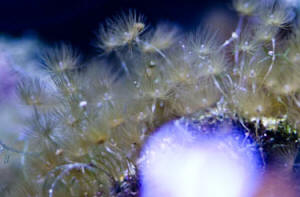
|
|
Critters on Glass, 1/12/11
Hi Crew!
<Hello>
I was wondering if these are tomont cysts attached on my aquarium
glass.
<Are not, the cysts are not visible to the naked eye.>
These were the best pictures I could take. My tank is fallow
right now but wanted to know if I should knock these off to be
sucked up through my filter.
Thanks for the info.
Tammy
<Looks like they might be hydroids,
http://www.wetwebmedia.com/hydrozoans.htm
.>
<Chris>
Hydroid Jellies 1/12/11
Hi Crew! I was wondering if these are tomont cysts attached on my
aquarium glass.
<Mmm, no. These are very likely Jellies, Hydroids. See
here:
http://wetwebmedia.com/hyzoidf3.htm
These were the best pictures I could take. My tank is fallow
right now but wanted to know if I should knock these off to be
sucked up through my filter.
Thanks for the info.
Tammy
<Mmm, they'll likely "disappear" of their own
accord in time (days to weeks). If there are only a few I would
not be concerned... If numerous, they might sting your purposeful
livestock. Bob Fenner>
|
|
 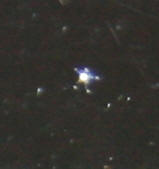
|
|
Re: Critters on Glass, 1/12/11
Thanks for the info but these are about the size of the head of a
straight pin or the dot of a pen.
<I would still bet on them being hydroids.>
This is a very close close-up of the "thing" in
question. Never had them in my tank before until I had an Ich
epidemic...
<Unrelated except that the tank being fallow probably allowed
these to propagate a bit better than before.>
hence the fallow tank. I'm thinking it's something I
should continue to get swept out but I didn't want to try if
they were say copepod eggs, amphipod eggs, good things.... would
love to know what they are.
Thanks.
Tammy
<Not something I would be overly concerned with, can be
removed if they bother you, but you will not most likely get them
all.>
<Chris>
Re: Re:
Thanks!
<Welcome>
<Chris>
|
|
|

